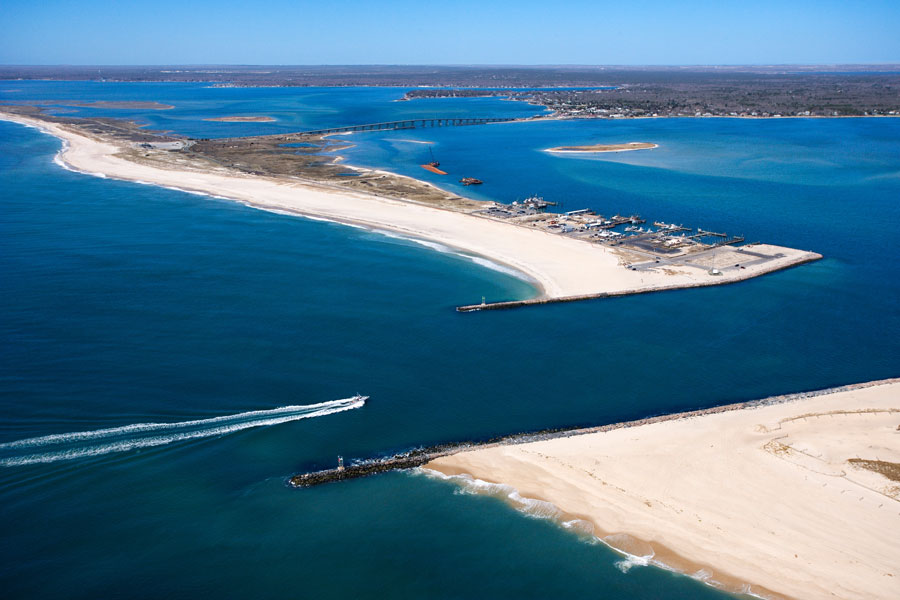Shinnecock Bay, Long Island

Shinnecock Bay is one of the most defining natural features of eastern Long Island’s South Fork – an expansive, shallow estuary bordered by Hampton Bays, Shinnecock Hills, and the barrier beach that separates it from the Atlantic Ocean. Long celebrated for its fishing grounds, maritime culture, and connection to the Shinnecock Indian Nation, the bay remains both a working waterway and a protected ecosystem. It is a place where boats still leave before dawn, where shellfish beds and tidal creeks shape daily life, and where the bay’s future depends on careful stewardship as much as its past depends on centuries of tradition.
Location & Geography
Shinnecock Bay covers approximately 9,000 acres and sits at the western edge of the Hamptons, connected to the Atlantic through the Shinnecock Inlet. To the north, roads and residential areas follow the shoreline through Hampton Bays and Shinnecock Hills; to the south, narrow stretches of dunes and marshland run along Dune Road, offering miles of ocean and bayfront views.
The Shinnecock Canal marks the western boundary of the bay and connects it to the Peconic Bay system, making it one of the most important marine transit points on Long Island.
History & Cultural Significance
The name “Shinnecock” comes from the Shinnecock Indian Nation, who have lived along the bay for thousands of years. For them, these waters were-and still are-a source of sustenance, identity, and cultural continuity. Fishing, shellfishing, and canoe travel defined life long before the arrival of European settlers.
By the 19th and 20th centuries, commercial fishing and clamming made the bay a regional economic engine. While much of that industry has declined, the heritage is still visible in local marinas, seafood markets, and the ongoing fight to restore shellfish populations.
Recreation on the Bay
Shinnecock Bay attracts everyone from casual beachgoers to serious anglers. Some of the most popular access points include:
- Meschutt Beach – family-friendly bay beach with calm water, food, and sunset views
- Ponquogue Bridge area – walking and fishing spot, with scenic views in every direction
- Shinnecock Canal & Marina – boat ramps, fishing spots, marina services
- Tiana Beach & other Dune Road access areas
Boating, kayaking, paddleboarding, and charter fishing are some of the most common activities, and the inlet remains one of the best places on Long Island for catching fluke, striped bass, bluefish, and blackfish.
Wildlife & Ecology
Shinnecock Bay is one of the most biologically productive estuaries on Long Island. Its shallow waters support eelgrass beds, tidal wetlands, and nursery habitat for marine species. It is also home to:
- Osprey
- Herons & egrets
- Terrapins & horseshoe crabs
- Shellfish & crustaceans
- Migratory waterfowl
Because of its ecological importance, the bay is part of the South Shore Estuary Reserve and is the focus of major restoration work led by Stony Brook University, The Nature Conservancy, and local partners.
Environmental Concerns & Restoration
Like many coastal systems, Shinnecock Bay has faced challenges from nitrogen pollution, algal blooms, habitat loss, and storm damage. In response, researchers and local organizations have launched long-term restoration projects involving:
- Shellfish seeding
- Eelgrass restoration
- Living shoreline projects
- Water quality monitoring
- Community education
These initiatives aim to replenish shellfish populations, improve water clarity, and protect the bay for future generations.
Vicinity of the Shinnecock Inlet
Key Facts
| Feature | Details |
|---|---|
| Location | Southampton, Long Island |
| Size | ~9,000 acres |
| Type | Tidal estuary & shallow bay |
| Inlet | Shinnecock Inlet (Atlantic access) |
| Bordering Communities | Hampton Bays, Shinnecock Hills, Tuckahoe |
| Cultural Importance | Home to the Shinnecock Indian Nation |
| Main Recreation | Fishing, boating, swimming, kayaking |
Shinnecock Bay is not simply a scenic stretch of water-it is a living cultural, historical, and ecological resource. From its Indigenous heritage to its role in modern marine conservation, the bay reflects both the past and future of Long Island’s South Fork. Whether you arrive by boat, spend a day clamming along the shoreline, or watch the tide come in at Meschutt Beach, Shinnecock Bay remains one of the most powerful reminders of why Long Island’s coastal environments matter.

